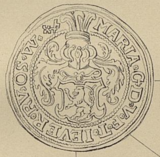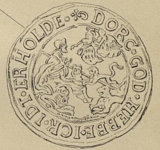Danielstaler
The Danielstaler , spelling also Daniel-Taler and Danieltaler , are talers of the Jever rule from the reign of Fraulein Maria (1536-1575). They were minted in two variants with the year numbers 1561 and 1567 and without a year. On the back they show the biblical episode of " Daniel in the lions' den " in the apocryphal version Dan 14: 23–42 EU .
Coin-historical connections
Maria was the second daughter of the chief of Jever, Edo Wiemken the Younger, and his wife Heilke (Heilwig), née Countess von Oldenburg . She came to the government together with her older sister Anna and the younger Dorothea when her brother, the young chief Christoph, suddenly died in 1517. When Miss Anna died in 1536, Maria was the sole regent of Jever.
Due to the policy of Count Enno II of East Friesland (1528–1540) as well as Edzard II and John of East Friesland, she was in dire straits. The counts demanded from Maria the supremacy of East Friesland over Jever.
The biblical episode “Daniel in the lions' den”, which serves as the motif on the back of the thaler, was chosen by the mistress of Jever with great probability as an allusion to her distressed situation. Maria demonstrated her assertiveness against the Counts of East Friesland with the high-profile means of minting coins , with the symbol on the reverse . The reverse of the Daniel thaler shows the chief daughter Maria as "Daniel in the lions' den". The lions symbolize the Counts of East Friesland and the prophet Habakkuk, led by an angel, the fiancé of Mary, Boing von Oldersum , who changed sides and drove the East Frisian occupation out with the help of Brunswick mercenaries .
In his Historical Coin Amusement, Johann David Köhler dealt with the symbolic coins , especially the Daniels of Maria von Jever.
From Köhler's coin amusement
(Volume 14, XXIV – XXXI)
The letters “DO” (only “D” in the illustration in the legend) that appear on thalers in the title of Fräuleins Maria should, according to Köhler, “be read correctly”. With the legend D (ochter) • V (nd) • F (räulein) • T (ho) • IEVER (n)…, the “title of a born daughter”, Maria has to assert her innate right of inheritance “to the free rule of Jever” tries. As “the chief Edo Wimekens, with his second wife Heilwig Gr. von Oldenburg and Delmenhorst legitimate middle daughter "she had a legal claim against the" enormous claim of the Count of East Friesland. "
" Daniel , miraculously preserved by God in the lion's pit, is supposed to indicate," says Köhler, "how Count Enno and Johann A. took possession of Jevern Castle on September 7th in 1527 under the guise of a friendly neighbor , the Miss [Mary and Anna] servants continue creating [n] and even held therein as captured and their vätterlichen heritage entwaltigt [are]. "faithful" Drost Boing of Oldersum [has] A. 1531 in May [the] abandoned Miss accepted and [to them] Jever again granted […]. ”In the coin image he is depicted as Habakkuk. "The [...] divine help to overcome her enemies, which she praised on the Thalers, only came back to her through the protection letter issued by K. Carln V.A. in 1531 for 6 years [...] and its prohibition. “According to this, the Counts of East Friesland were forbidden to act “ outside the law [...] ” against the rule of Jever“ in the event of the highest disgrace and penalty of 50 marks of soldered gold ” . Count Enno had, according to Köhler, "to stop all illegal actions against [Maria], [...] because the emperor threatened him with the eight ."
annotation
Emperor Charles V, the Maria asked for help, had in his capacity as Duke of Brabant and Count of Holland , the Jeverland repossessed and her a Burgundian Lehnsvertrag issued for it.
Maria determined by her will of April 22, 1573 Count Johann XVI. von Oldenburg [(1573) 1577–1603] ("the dyke builder") to her legacy. That was the last demonstratively effective measure against the East Frisian count house.
The coin ban
Because of her feudal relationship with Burgundy, Maria had gotten into a peculiar double position. They thought he was entitled to choose whether after the imperial coinage or after the Burgundian standard of coinage minted coins. They decided to mint according to the lighter Burgundian coinage. This is probably why it omitted the year of issue of the first Daniels thalers minted before 1561. So it was not possible to tell whether their coins were minted after the time of the Augsburg Imperial Coin Regulations introduced in 1559 or even before that. From 1561 the year of issue is again indicated on all coins.
In 1563, the Jever coins were officially tested on the "Probation Day of the Dutch-Westphalian district of Cologne " and found not to comply with the Imperial Coin Order . She was charged with “improper coinage”. Maria explained that as a feudal bearer from Burgundy, she was neither subject to the imperial coinage system nor the jurisdiction of the imperial chamber court and therefore did not recognize the court. That gave her a delay of several years. It was not until 1566 that the coin rack was revoked by a court order . However, this did not prevent them from continuing to mint the Daniels thalers in 1567. These talers from 1567 with the changed inscription AFTER • DES • H (hasty) • REICHS • SC (h) RODT • VND • KORN gives the impression that P. v. Lehmann, "she has given up her previously exceptional point of view". The fact that she had the thalers minted even though her right to mint was withdrawn the year before "hardly suggests" that she wants to comply with the coinage laws of the empire. The purpose of this inscription was probably that she wanted to give the thaler a larger circulation area, which she actually succeeded in doing.
The inscription with reference to the fineness of the taler, as required by the Reich Coin Order, was therefore only a calculation.
annotation
The last thalers of Mary were minted in small numbers in 1573.
Coin description
Described is the thaler shown above from 1567 (second variant)
The Daniel thaler is a silver thaler coin of Mary of Jever of the Jever rule. The thaler shown weighs 28.99 grams and has a diameter of 41 millimeters. The mint master Dirk Iden was responsible for the coinage . The thalers were minted in the Jever mint with the mint master's mark four-petalled flower.
front
The front shows the helmeted lion coat of arms of the Jever rule. The year 6 - 7 (1567) is on both sides of the helmet.
- Transcription: MARIA • G (eborene) • D (ochter) • V (nd) • FR (outer) • T (o) • IEVER (n) • RV (strigen) • OS (trigen) • V (nd) • W (angerland)
back
The reverse shows the biblical episode of "Daniel in the lions' den" as a motif. Daniel is sitting in the lions' den. The prophet Habakkuk is led by a hovering angel who brings food and drink to the prisoner.
- Inscription: nach • DES • H (hasty) • REICHS • SC (h) RODT • VND • KORN
The first variant of the Daniel thaler from 1561 or the one without the year bears the motto DORC (h) GOD HEBBE ICK IDT ERHOLDEN (through God I received it) instead of specifying the fineness . The backside picture shows differences in the details.
literature
- State Library Oldenburg digital: P. v. Lehmann: The thalers and small coins of Miss Maria von Jever ... , Wiesbaden, 1887
- Johann David Köhler: Historischer Münz-Amustigung , published weekly in 1729 , Volume 14, 1737
- Otto zu Stolberg-Wernigerode: New German Biography , Volume 16, Berlin 1990, p. 186: Maria, Fräulein zu Jever
- Helmut Kahnt: The large lexicon of coins from A to Z , Regenstauf 2005
Individual evidence
- ↑ Helmut Kahnt: The large coin dictionary from A to Z (2005), p. 84: Daniel-Taler
- ^ Friedrich von Schrötter, N. Bauer, K. Regling, A. Suhle, R. Vasmer, J. Wilcke: Dictionary der Münzkunde , Berlin 1970 (reprint of the original edition from 1930), p. 120: Danielstaler
- ↑ P. v. Lehmann: The thalers and small coins of Fraulein Maria von Jever ... (1887), p. 10
- ↑ Helmut Kahnt: Das große Münzlexikon von A bis Z (2005), p. 84: As an allusion to the distressed situation.
- ↑ P. v. Lehmann: The thalers and small coins of Miss Maria von Jever… (1887), p. 55/62
- ^ Johann David Köhler: Historischer Münz-Amustigung Volume 14 (1737), XXIV – XXXI
- ↑ P. v. Lehmann: The thalers and small coins of Fraulein Maria von Jever ... (1887), p. 62: Burgundian loan contract
- ^ Max Wilberg: Regentenpabellen ... , Frankfurt (Oder) 1906. Photomechanical reprint of the original edition, Berlin: Transpress, 1987, p. 35
- ↑ Otto zu Stolberg-Wernigerode: New German Biography , Volume 16, Berlin 1990, p. 186: Maria, Fräulein zu Jever designated Johann XVI von Oldenburg (1540–1603) as heir
- ↑ P. v. Lehmann: The thalers and small coins of Fraulein Maria von Jever ... (1887), p. 41; 42
- ↑ P. v. Lehmann: The thalers and small coins of Fraulein Maria von Jever… (1887), p. 67: In 1566 Maria was deprived of the coin shelf
- ↑ P. v. Lehmann: The thalers and small coins of Miss Maria von Jever… (1887) p. 57: Purpose of the inscription
- ↑ P. v. Lehmann: The thalers and small coins of Miss Maria von Jever ... (1887) p. 67: The last thalers
- ↑ P. v. Lehmann: The thalers and small coins of Fraulein Maria von Jever… (1887), p. 57: Münzzeichen
- ^ Münzkabinett Berlin: Mint Jever
- ^ Johann David Köhler: Münz-Amustigung Volume 14 (1737), XXIV
- ↑ Johann David Köhler: Münz-Amustigung Volume 14 (1737), XXVIII (4)



